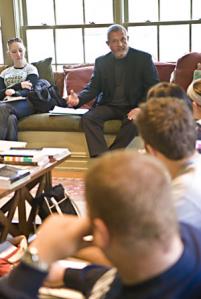The ancient Greeks had it right when they personified memory, in the form of the goddess Mnemosyne, as the mother of the muses--those mythical beings who whisper inspiration into the ears of writers, visual artists and performing artists. Creativity is certainly Memory's child.
When experienced writers tell aspiring ones, Write what you know, they don't necessarily mean that what we write should be literal or fact-based. They mean for us to dip into the grab bag full of experiences each of us has lived. They mean memories wait there for us to pull out onto a page in some new way. They mean that no memory should be thought unworthy of use if it helps us say what we need to say.
 In my garden is a stone I bought at the Holocaust Memorial Museum in Washington, D. C. It has the word Remember cut into its speckled surface. Its message, to me anyway, is that remembering serves us well whether the memories are good or bad or just there, with no judgment attached, because each of us sees and experiences something uniquely. No two people have the exact same experience, and no two people write about similar experiences in the same way.
In my garden is a stone I bought at the Holocaust Memorial Museum in Washington, D. C. It has the word Remember cut into its speckled surface. Its message, to me anyway, is that remembering serves us well whether the memories are good or bad or just there, with no judgment attached, because each of us sees and experiences something uniquely. No two people have the exact same experience, and no two people write about similar experiences in the same way.
I brought this rock inside last Saturday before my writers arrived and cleaned the cobwebs and dirt from it. Then we passed it around as a sort of cool talisman on a hot day as we each read a stanza of the poem In the Lebanese Mountains by Nadia Tueni. We talked a bit about the poem--how Tueni's use of sensory language and unexpected imagery made us feel as if we, too, were in the faraway place she described. The prompt I then gave them was to evoke a place they knew from memory, and whether they wrote it in the form of poetry or prose, to repeat the word remember, as Tueni does.
No surprise that each writer came up with something completely different. Here's what I wrote...
No surprise that each writer came up with something completely different. Here's what I wrote...
by Susan Lawson
Remember the dance of daylight savings time?
No school
Staying up long after
the sun went to bed
Catching fireflies in mayonnaise jars
Holes dads punched with screwdrivers
into screw-top lids
Bits of grass added
to ease our consciences until tomorrow
Thinking we could keep
the moment alive
if we ran fast enough.
Remember the gaggle of parents watching from the patio?
Cigarettes in one hand
Scotch in the other
The clink of ice in crystal glasses
The silvery smoke trail that curled into the darkness
on wrinkles of laughter
Tips of gentle embers
we could spot
from the vacant lot next door, summer’s homing beacon.
Remember them
always on guard,
or pretending to be?
They found safety in numbers, just like us.
How we knew a hush meant
not for little ears
How we hid in the lilac bushes
to hear the dirty joke we wouldn’t understand and
were overcome
by scent.
Remember them
perched in those folding aluminum lawn chairs?
Plastic webs that
stretched and frayed
and then collapsed.
Remember dirty bare feet against starched white sheets?
Parents who seemed so old then, and now
I am older still
remembering us young.
Here is Tueni's poem as it appears in the anthology This Same Sky: A Collection of Poems from Around the World, selected by Naomi Shihab Nye:
by Nadia Tueni (translated by Samuel Hazo)
Remember—the noise of moonlight
when the summer night collides with a peak
and traps the wind
in the rocky caves of the mountains of Lebanon.
Remember—a town on a sheer cliff
set like a tear on the rim of an eyelid;
one discovers there a pomegranate tree
and rivers more sonorous
than a piano.
Remember—the grapevine under the fig tree,
the cracked oak that September waters,
fountains and muleteers,
the sun dissolving in the river currents.
Remember—basil and apple tree,
mulberry syrup and almond groves.
Each girl was a swallow then
whose eyes moved like a gondola
swung from a hazel branch.
Remember—the hermit and goatherd,
paths that rise to the edge of a cloud,
the chant of Islam, crusaders’ castles,
and wild bells ringing through July.
Remember—each one, everyone,
storyteller, prophet and bakers,
the words of the feast and the words of the storm,
the sea shining like a medal in the landscape.
Remember—the child’s recollection
of a secret kingdom just our age.
We did not know how to read the omens
in those dead birds in the bottoms of their cages,
in the mountains of Lebanon.
the cracked oak that September waters,
fountains and muleteers,
the sun dissolving in the river currents.
Remember—basil and apple tree,
mulberry syrup and almond groves.
Each girl was a swallow then
whose eyes moved like a gondola
swung from a hazel branch.
Remember—the hermit and goatherd,
paths that rise to the edge of a cloud,
the chant of Islam, crusaders’ castles,
and wild bells ringing through July.
Remember—each one, everyone,
storyteller, prophet and bakers,
the words of the feast and the words of the storm,
the sea shining like a medal in the landscape.
Remember—the child’s recollection
of a secret kingdom just our age.
We did not know how to read the omens
in those dead birds in the bottoms of their cages,
in the mountains of Lebanon.










